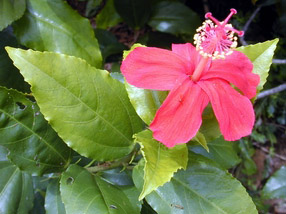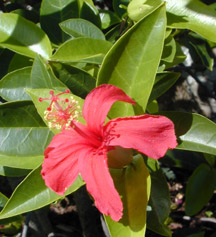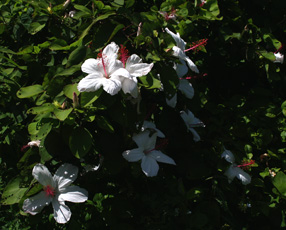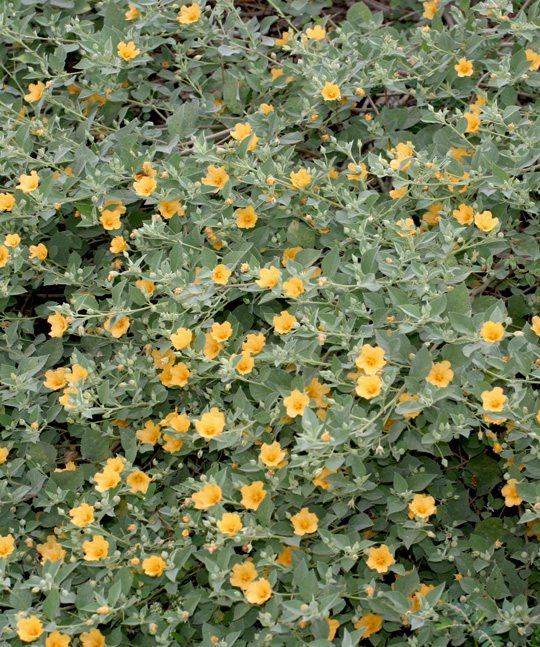
- INTRODUCTION
- Geology
- The Seasons
- In Memoriam (Jim)
- RESTORATION
- PRINCIPALS
What is Nā Pōhaku o Hauwahine?
Nā Pōhaku o Hauwahine is the given name of a 12-acre piece of state property under the Department of Land and Natural Resources (DLNR), Division of State Parks and part of the Kawainui State Park Reserve. The parcel is located along Kapa‘a Quarry Road in Kailua (O‘ahu) overlooking Kawai Nui Marsh. It is a place of unique geological and cultural features where plants native to the Hawaiian Islands are planted for the enjoyment and education of visitors. It is also an experiment in recreating a landscape now lost on O‘ahu. Development of the "park" reflects the efforts of many, many volunteers under the guidance of ‘Ahahui Mālama i ka Lōkahi (AML). The park is open to the public for easy day-hiking (excellent for familes with young children) 7 days a week, from 08:00 AM to 5:00 PM <2>. During much of the Covid Pandemic the state park was closed by order of the DLNR. The park is now (2022) open to visitors.
Many features contribute to the value and uniqueness of this particular place, but foremost in my mind are the native plants. To understand why this particular aspect has any significance at all requires an understanding of the status of wild plants on the Island of O‘ahu or, for that matter, generally in the Hawaiian Islands. These Islands are home to nearly 1,100 native plant taxa (species, subspecies), many now endangered, and the majority no longer found in any places where most residents or visitors go, unless they be avid hikers. Notable exceptions are Hawai‘i Volcanoes National Park, Saddle Road above Hilo, and other upland areas accessible by car (for example, the upper end of Halawa Valley as seen, but not accessed, from H-3). If we believe Hawai‘i is a special place and a reason for that is native Hawaiian culture, then consider that preservation of a culture becomes increasingly difficult once the landscape reflects nothing of the environment in which the culture developed. Should the Hawai‘i you know and live in, that tourists visit, be no different than any other tropical place in the world? Our rocks and hills are not physically unique. It is only the native vegetation and native animals that truely distinguish Hawai‘i from other tropical lands; and, of course the native Hawaiian culture that came out of that past natural environment. Unfortunately, that environment is now all but gone to the majority of residents in the State of Hawai‘i.

• Hibiscus brackenridgei A. Gray
....I stood and considered the state of the garden, the daunting magnificence of its declension from May's straightforward rows and intentions. Whenever I hear or read the word garden, I always picture something so much less wild than this, probably because in common usage garden stands as the opposite of wilderness. The gardener knows better than to believe this, though. He knows that his garden fence and path and cherished geometries hold in their precarious embrace, if not a wilderness – Michael Pollan, The Botany of Desire,
in any literal sense, then surely a great, teeming effulgence of wildness—of plants and animals and microbes leading their multiferous lives, proposing so many different and unexpected answers to the deep pulse of their genes and the wide press of their surroundings—of everything affecting everything else.
p. 241-2.
So, what are "native" plants?
Endemic Hawaiian plants occur nowhere else in the world in nature. Indigenous plants are typically plants that are adapted to disperse across the ocean, and so are native here as well as other Pacific Island locations. All other species of plants growing in the islands are either ornamental/agricultural (planted and requiring care) or naturalized. Naturalized plant species are those that have been introduced by man for one reason or another (often accidently) and have subsequently succeeded in establishing in the wild. The total number of these non-native species here is subject to debate, but naturalized plant taxa listed by Wagner, Herbst, and Sohmer <5> in 1990 was put at 869 (includes 24 Polynesian introductions) and is certainly a much larger number today. Total plant taxa growing in the islands certainly exceeds 8000 (Staples and Herbst, 2005<6>). Suffice it to say that the lowlands of the islands are now so dominated by naturalized and ornamental species, that very little of the vegetation you see around you has any connection to Hawaiian culture or the landscape as it appeared before the arrival of Captain James Cook in 1778.
A number of native plant species are gaining popularity in landscaping, considerable credit for which is due Rick and Matt of Hui Kū Ma‘oli Ola. Many of the plants growing at Nā Pōhaku come from the Hui Kū nursery. Most I have have provided from my private nursery in nearby Kāne‘ohe. These new botanical contributions are grown from seeds and cuttings of the plants already present at Nā Pōhaku, with an occassional infusion of genetic material collected from elsewhere in the Islands.

• Hibiscus kokio Hillebr.

• Hibiscus clayi Degener & I. Degener
The efforts of volunteers at Nā Pōhaku have been ongoing for many years, beginning modestly sometime in the 1990s, but well underway by the turn of the Millennium. Volunteers have come and gone, a few staying much longer than most. This web document is largely the story of those few that have hung-on through many seasons and why they continue to return—what they are hoping to accomplish. And most importantly, what they have learned by observing the native plants.
Volunteers come for a multitude of reasons. For each participant, personal preferences and understandings come into play that may be very divergent from those of other volunteers. We sometimes discuss these viewpoints throughout the day, or more often during our very informal NPEG<1> Saturday lunch break. Although this document largely reflects my own beliefs as to what Nā Pōhaku o Hauwahine should be, accepting them is not something I or others require of any volunteer. The site is large enough to presently accommodate several other groups (including a group from Hawaii Pacific University and the monthly AML volunteer Saturday event). One need not even have a strong interest in native plants (a dislike of "weeds" helps); the work is varied and satisfaction is largely self-generated. Stay long enough, and you will experience a pride that comes from participating in positive visible changes to the landscape. Especially if you enjoy tending plants, gardening (weeding), and want to learn more about Hawai‘i's native flora, then you will want to join with us some Saturday. To learn more, read on. To volunteer contact the author or join a group from AML.
The NPEG group is developing a QR code guide system for visitors to the park. The system provides for self-guided tours by accessing web pages using your smart phone. QR codes displayed at various points along the trails present information on specific sites, plant identification, and directions along the trails to enhance the experience of visitors. Different color QR codes are used: brown for site information (mostly cultural) and navigation; green - for plant identification; and blue - for general information, instructions, and links to other useful web sites. The system is being deployed gradually starting in March 2022.
The unusual geology of Nā Pōhaku o Hauwahine ![]() CLICK HERE
CLICK HERE
Restoration efforts at Nā Pōhaku o Hauwahine ![]() CLICK HERE
CLICK HERE
The seasons at Nā Pōhaku o Hauwahine ![]() CLICK HERE
CLICK HERE

• Hibiscus arnottianus A. Gray

• Sida fallax Walp.
![]() Species list of native plants at Nā Pōhaku o Hauwahine
Species list of native plants at Nā Pōhaku o Hauwahine
![]() Links to websites about native plants and plantings in Hawai‘i nei
Links to websites about native plants and plantings in Hawai‘i nei